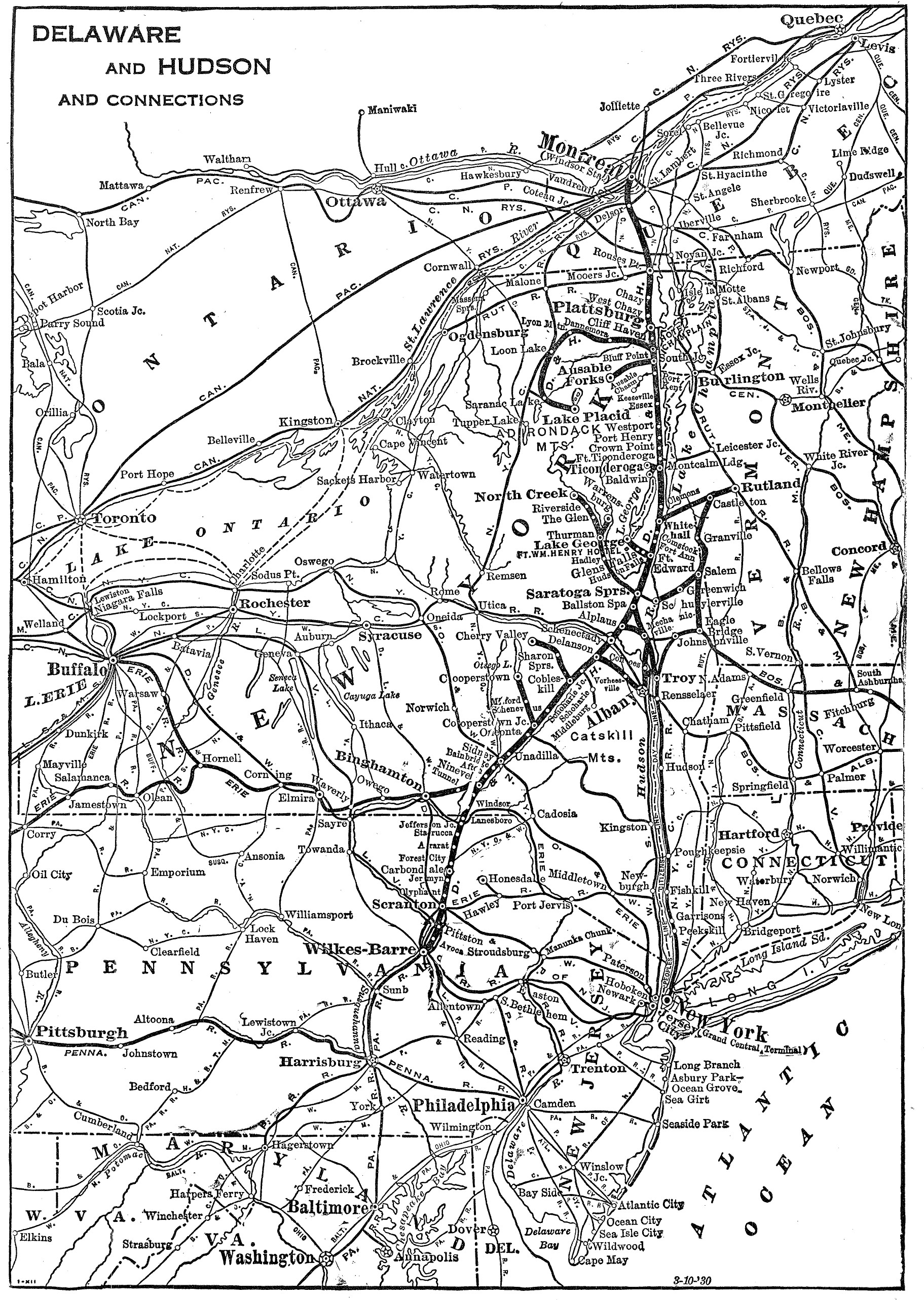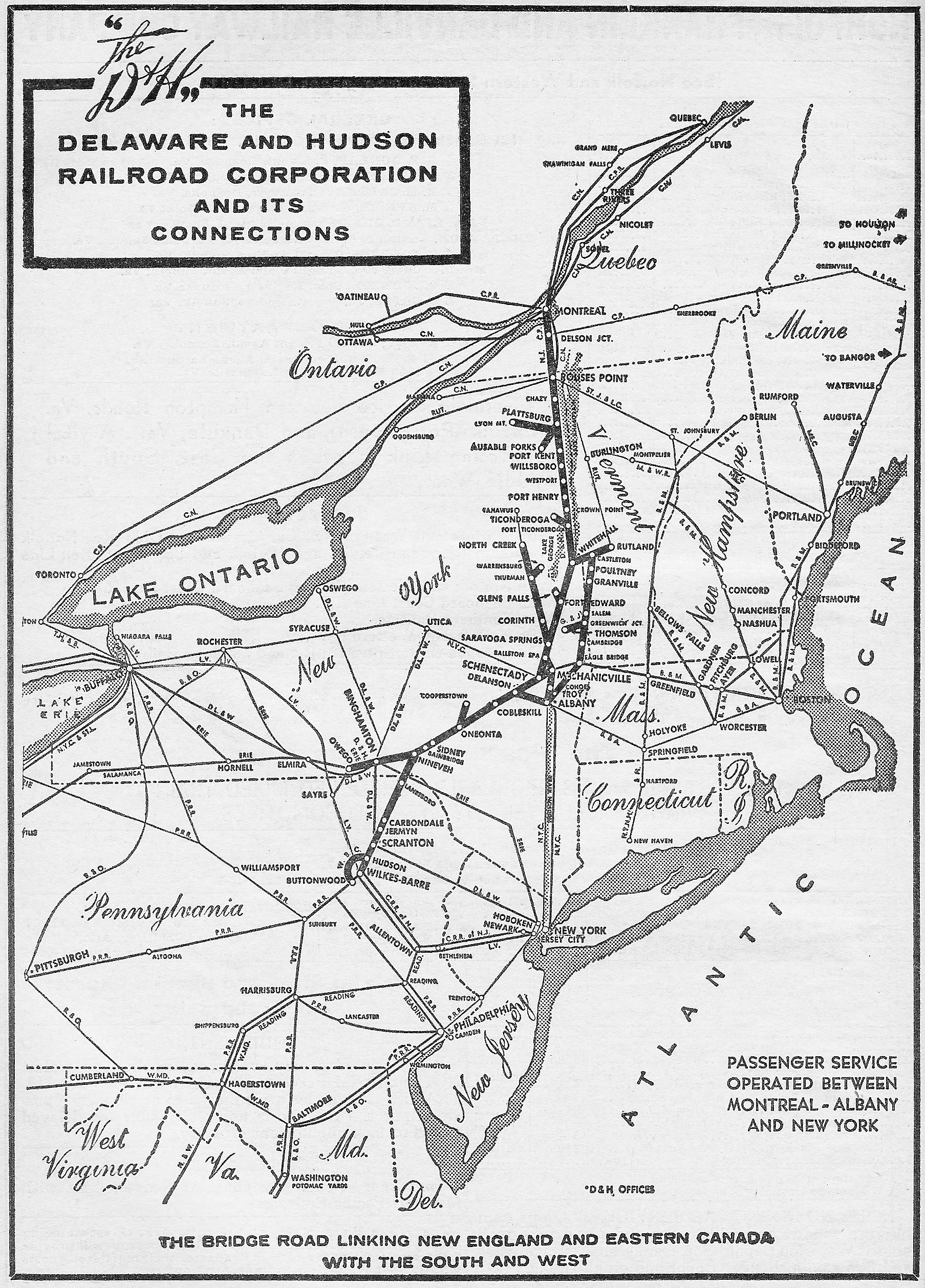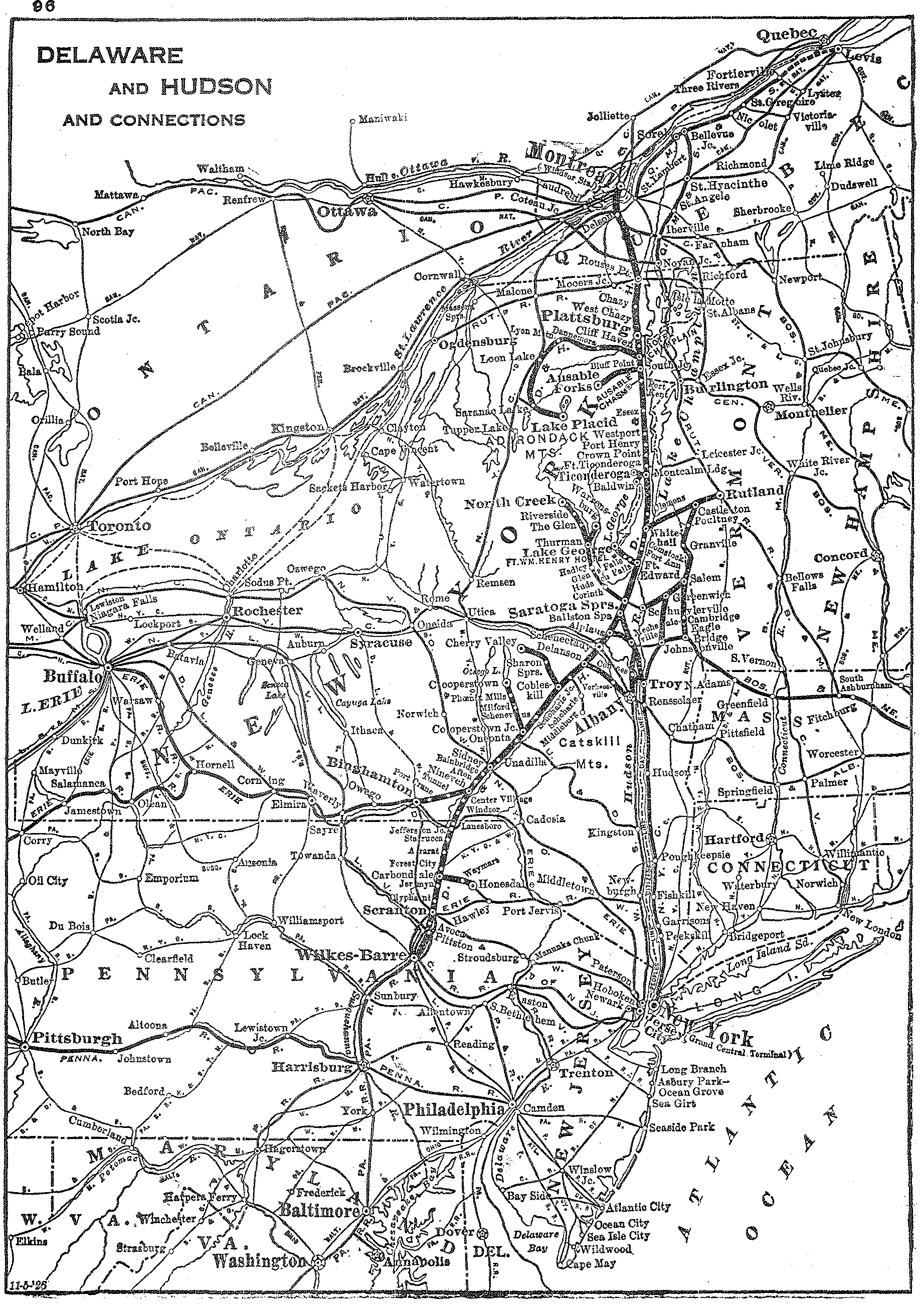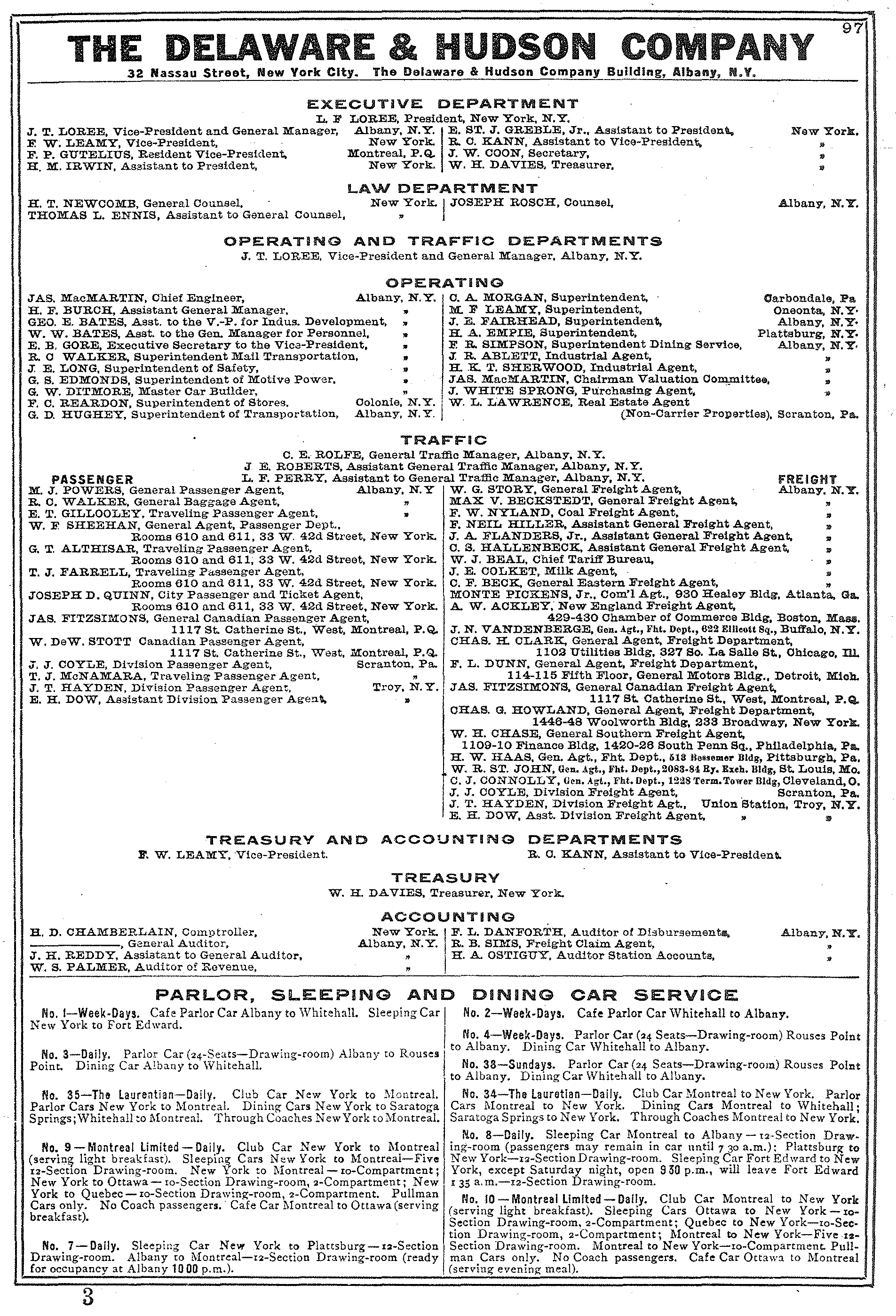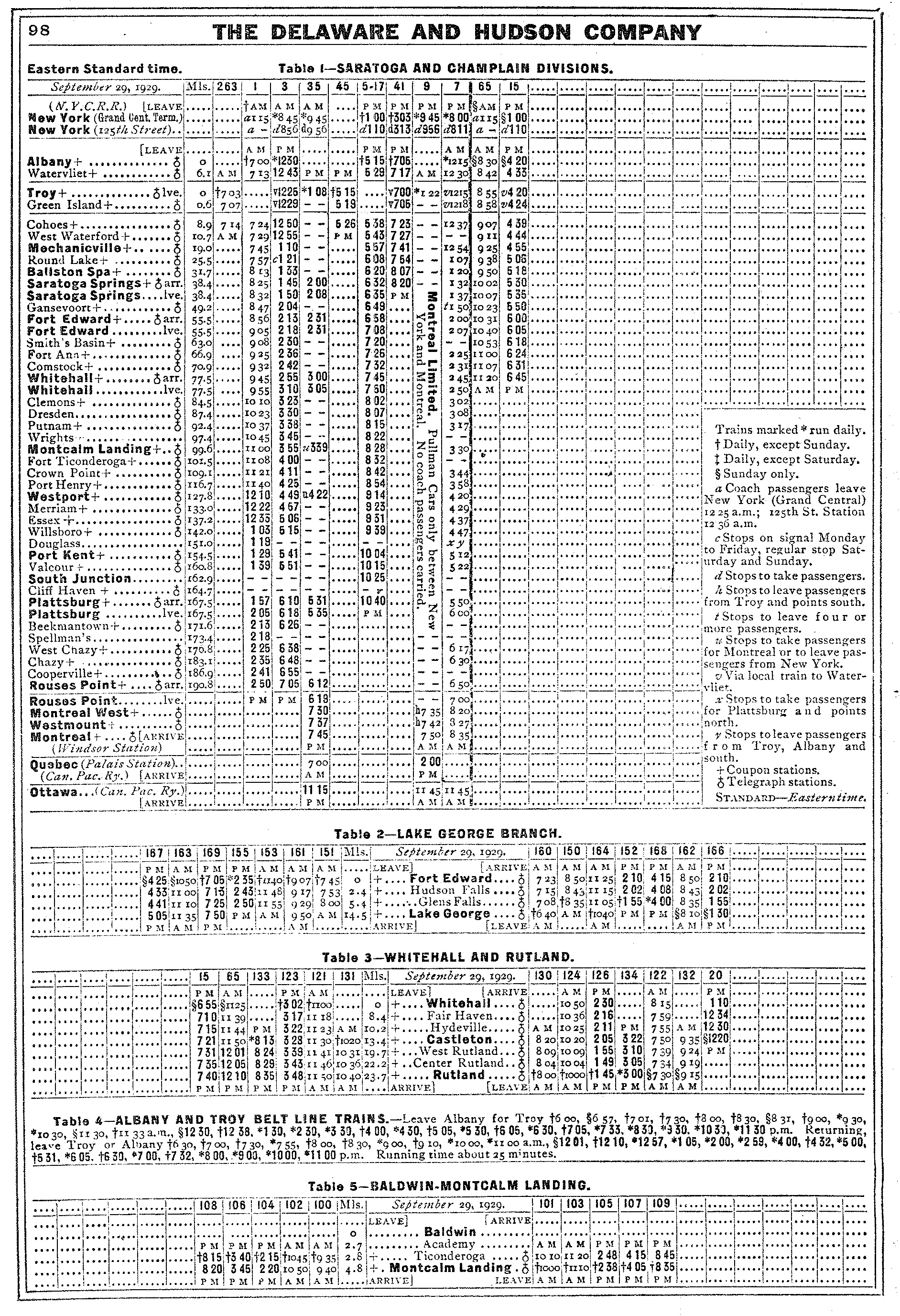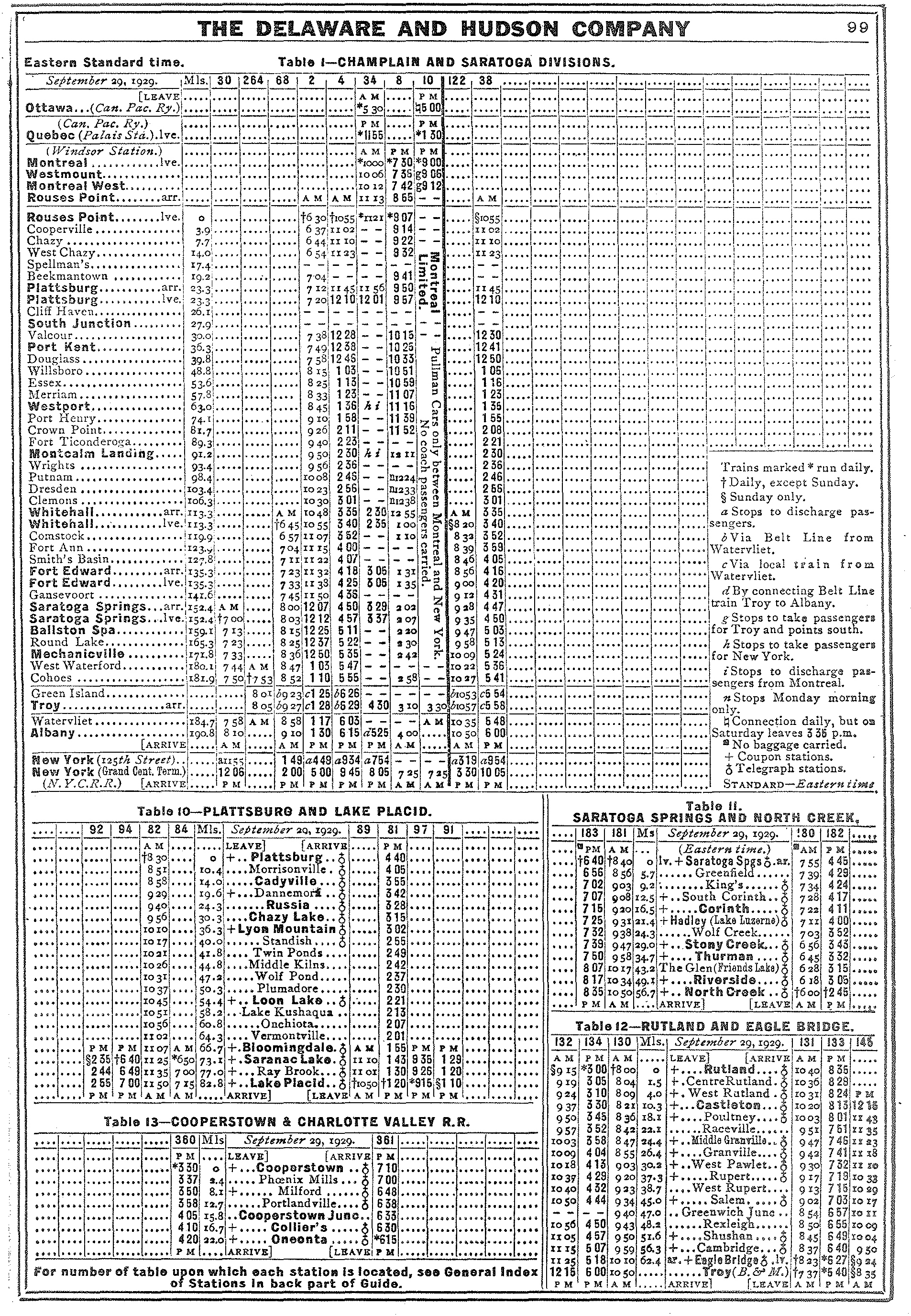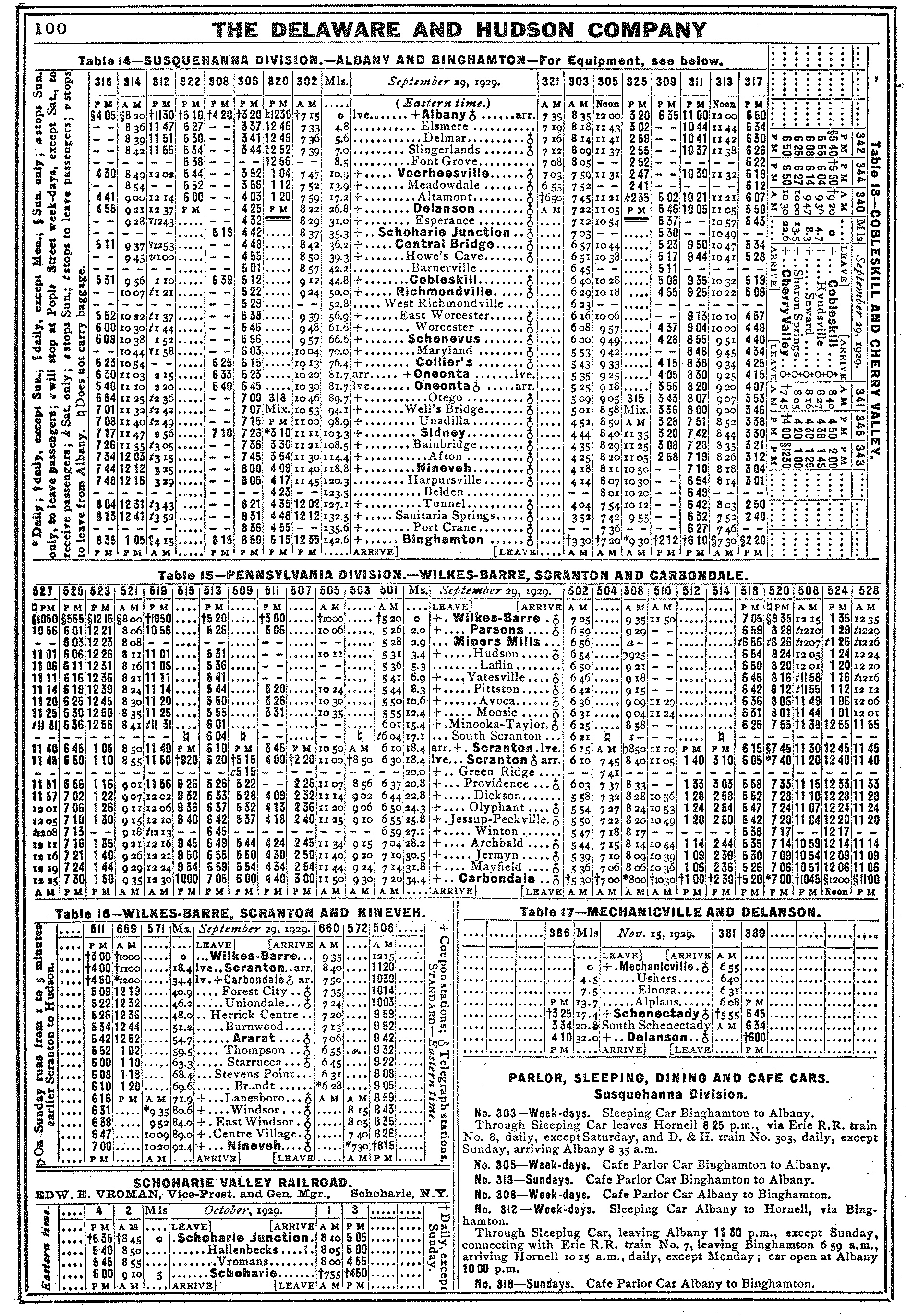Delaware and Hudson Railway: Map, History, Roster, Logo
Last revised: October 12, 2024
By: Adam Burns
The Delaware and Hudson Railway, was our country’s oldest surviving transportation company, with a corporate existence that spanned 168 years.
What's left of the railroad is now split between Canadian Pacific and Norfolk Southern. The D&H began as a canal operation, the vision of early entrepreneurs to transport anthracite coal from northeastern Pennsylvania to the metropolis of New York City.
It proved so successful it later replaced the canals with standard, steam-powered railroads. Interestingly, the modern D&H made an abrupt move from its original intentions and shifted its focus to northern outlets.
Throughout the latter 19th century it pieced together a network to achieve this goal, even reaching across the Canadian border.
As demand for anthracite declined it struggled in the postwar years and was eventually purchased by a private investor who later sold the property to Canadian Pacific. In 2015, part of its original main line was purchased by Norfolk Southern.
Pictures
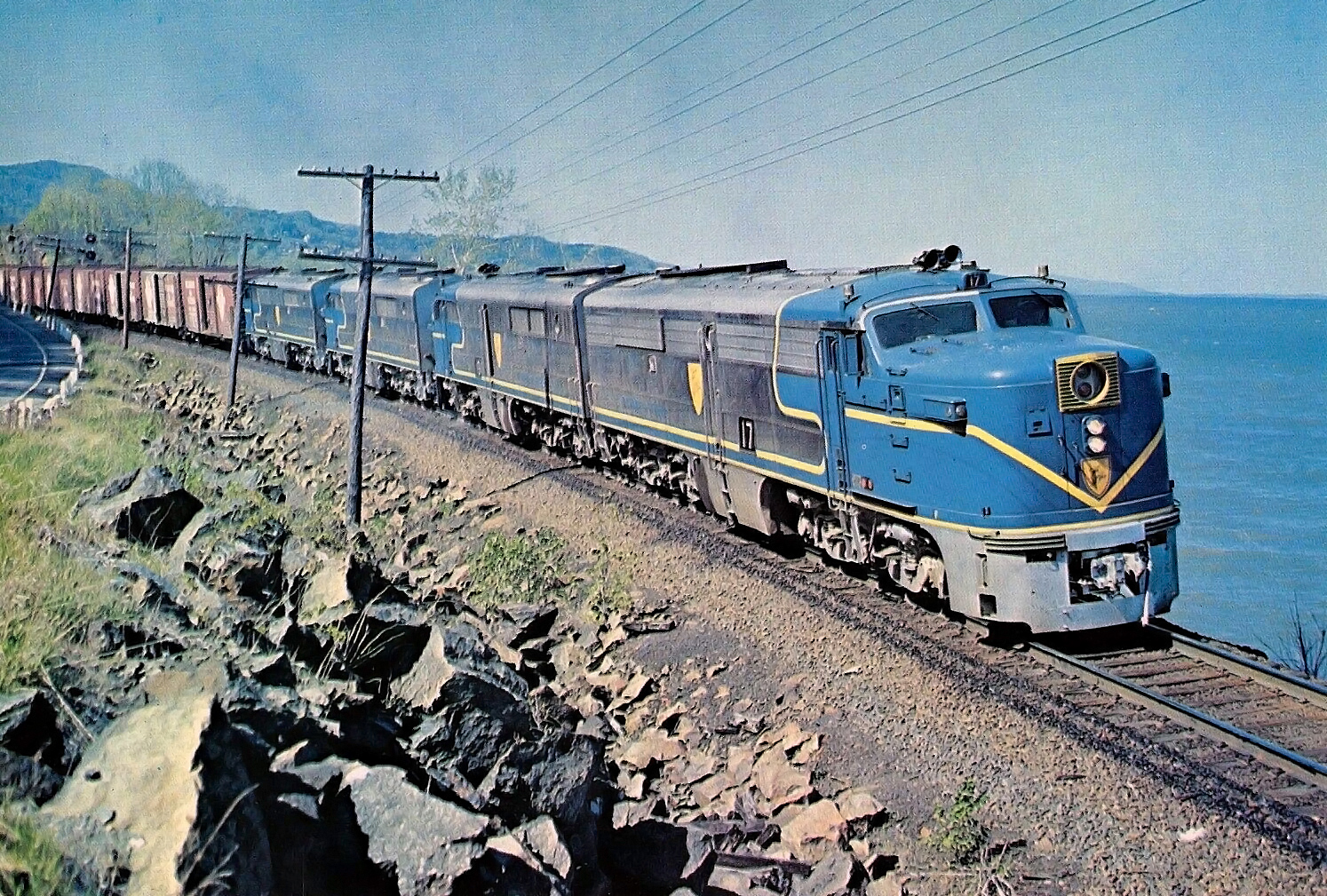 All four of Delaware & Hudson's PA's lead freight SC-20 along the shores of Lake Champlain near Port Henry, New York during the 1970s. Jim Shaughnessy photo.
All four of Delaware & Hudson's PA's lead freight SC-20 along the shores of Lake Champlain near Port Henry, New York during the 1970s. Jim Shaughnessy photo.History
There were many Northeastern railroads which depended greatly on anthracite coal. However, perhaps none other was more closely associated with this natural resource than the Delaware & Hudson Railway.
Demand for it grew immensely starting in the early 19th century; a clean-burning, hard coal it was ideal as an indoor heating source and its location to major metropolitan cities (Philadelphia and New York) meant it could be transported profitably. Exactly how, though, was a tough question.
The railroad had not yet been invented although canals offered promise. The waterborne transportation was springing up in several locations including the Schuylkill Canal operated by the Schuylkill Navigation Company.
At A Glance
765 (1950) 1,381 (2000) | |
Albany - Troy - Mechanicville, New York - Montreal, Quebec Albany - Schenectady - Binghamton, New York Binghamton - Owego, New York Nineveh, New York - Wilkes-Barre, Pennsylvania Hudson - Buttonwood Yard, Pennsylvania Delanson - Mechanicville, New York Schenectady - Balston Spa, New York Saratoga Springs - Tahawus, New York Troy, New York - Castleton, Vermont Whitehall, New York - Rutland, Vermont Plattsburg, New York - Lyon Mountain, Vermont Plattsburg - Ausable Forks, New York Fort Ticonderoga, New York - Ticonderoga, New York Oneonta, New York - Cooperstown, New York Cobleskill - Cherry Valley, New York | |
Owego - Buffalo/Niagara Falls, New York Wilkes-Barre - Harrisburg, Pennsylvania - Washington, D.C. Scranton - Allentown, Pennsylvania - Newark, New Jersey Allentown - Philadelphia | |
Freight Cars: 9,394 Passenger Cars: 55 | |
It entered full service in 1825, moving anthracite to Philadelphia from northern coal fields and unquestionably proved the concept's viability.
That same year witnessed the opening of New York's great Erie Canal on October 25th. The visionaries of the Delaware & Hudson Canal Company were brothers Maurice and William Wurts.
They had acquired tracts of rich anthracite veins in the Carbondale region and at first hoped to serve Philadelphia, their home city.
Delaware & Hudson Canal Company
Unfortunately, the Schuylkill Navigation Company was nearing completion making this idea an impossibility. New York, however, had no direct transportation service for anthracite making it a promising prospect. In 1823 the brothers concluded that a canal from their mines to Port Jervis was a feasible proposition.
The waterway would then strike out northeastward for Kingston before utilizing the Hudson River south. However, it was not without its difficulties.
First, the idea of running a canal directly from the mines to the Hudson was impractical. The formidable, Moosic Mountains, which climbed to more than 1,200 feet above sea-level east of Carbondale, made it cost prohibitive.
The men decided a gravity railroad would instead be built. According to Jim Shaughnessy's book, "Delaware & Hudson: Bridge Line To New England And Canada," the state of Pennsylvania authorized construction of a canal along the Lackawaxen River on March 13, 1823.
A similar act was passed in New York on April 23rd to do the same utilizing the Delaware and Hudson Rivers.
Logo
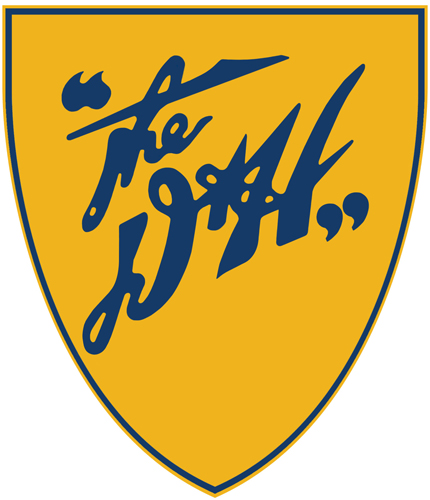
The canal would run east of Honesdale, connecting there with the gravity railroad. The Pennsylvania legislature authorized construction of the gravity line on April 5, 1826.
In the meantime, initial work on the canal began westward from the Hudson River at Eddyville (slightly south of Kingston it was then known as Eddy's Factory) and was open 60 miles to Mongaup along the Delaware River (and just northwest of Port Jervis) during the summer of 1827.
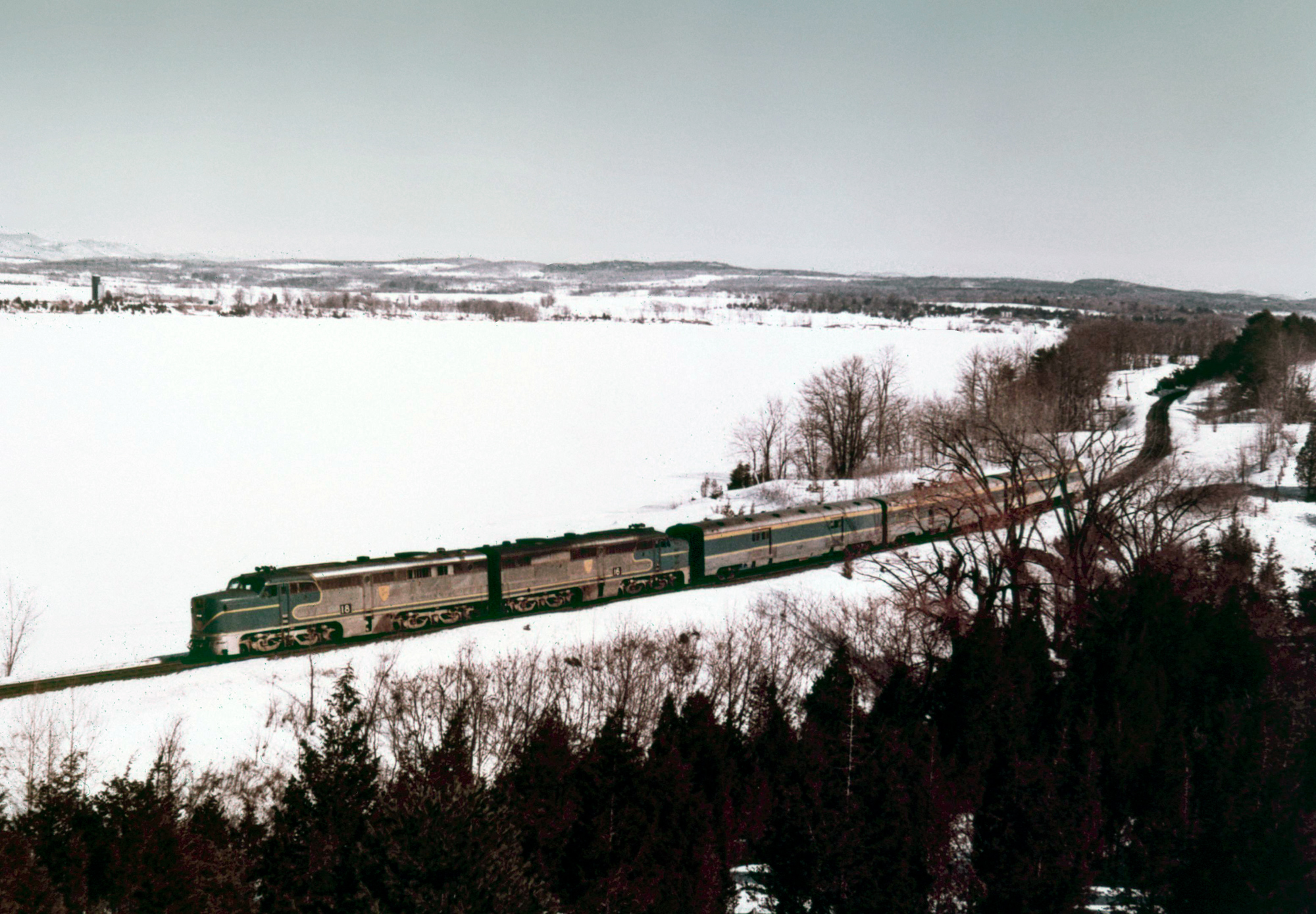 Delaware & Hudson PA-1's #18 and #16 lead the "Laurentian" northbound along Lake Champlain during the late 1960's. Jim Shaughnessy photo. American-Rails.com collection.
Delaware & Hudson PA-1's #18 and #16 lead the "Laurentian" northbound along Lake Champlain during the late 1960's. Jim Shaughnessy photo. American-Rails.com collection.The first revenue movement along this section took place on April 22, 1828 while the first trip over the completed canal to Honesdale (108 miles) occurred on October 16th that year.
Through the first half of 1829 the canal handled some coal tonnage using standard horse-drawn wagons during the railroad's construction.
The 17-mile gravity system finally opened on October 8, 1829 and the entire operation flourished. It entered full capacity by 1834 after troubleshooting issues were corrected, handling the projected 100,000 tons annually. With its success unquestioned, ownership eyed expansion of the railroad to mines south and west of Carbondale.
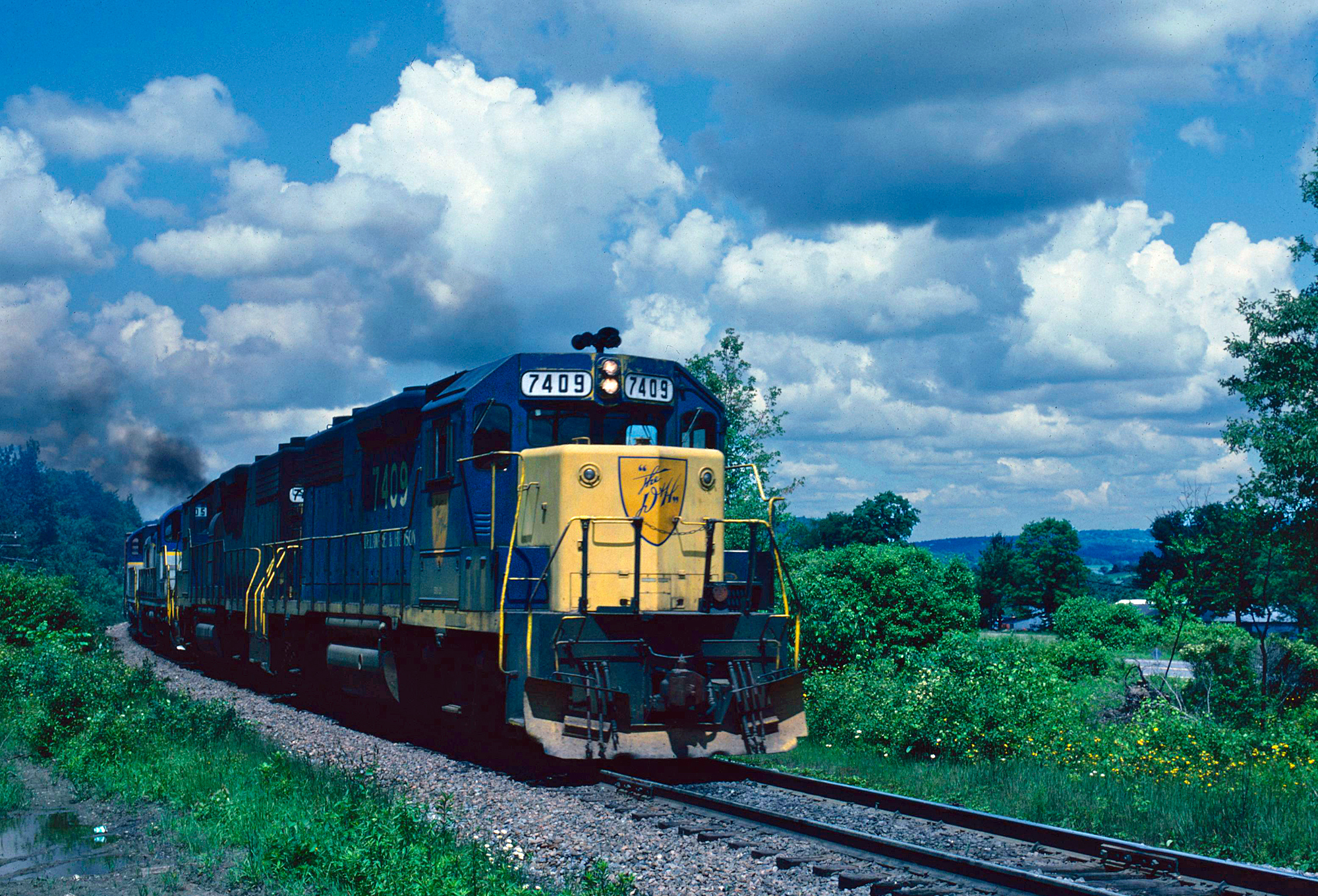 Delaware & Hudson GP39-2 #7409 leads a general manifest southbound at Conklin, New York in May, 1982. Fred Robinson photo. American-Rails.com collection.
Delaware & Hudson GP39-2 #7409 leads a general manifest southbound at Conklin, New York in May, 1982. Fred Robinson photo. American-Rails.com collection.In 1843 a 7-mile extension was carried out to White Oak Run within the Lackawanna Valley. Another addition took place in 1858 when 6 more miles opened to Valley Junction via Olyphant and Archbald.
The canal was expanded as demand soared requiring enlargements and revisions. By the mid-19th century, locomotives powered by steam boilers were proving the future in transportation.
In response, the D&H decided to employ them on a new section of standard railroad beyond Valley Junction. The 4-mile segment reached Providence, near present-day Scranton and opened in 1860.
The company ordered two, 4 foot, 3 inch-gauge locomotives; an 0-4-0 named Major Sykes (in 1872 the unit was rebuilt as an 0-6-0 following an accident) and a 4-4-0 named C.P. Wurts.
They were constructed by the W. Cook & Company of Scranton and constituted the first use of steam locomotives on the D&H in revenue service.
Interestingly, if the gravity operation had been built as originally designed by John B. Jervis, the company's first chief engineer, it would have utilized locomotives right from the start.
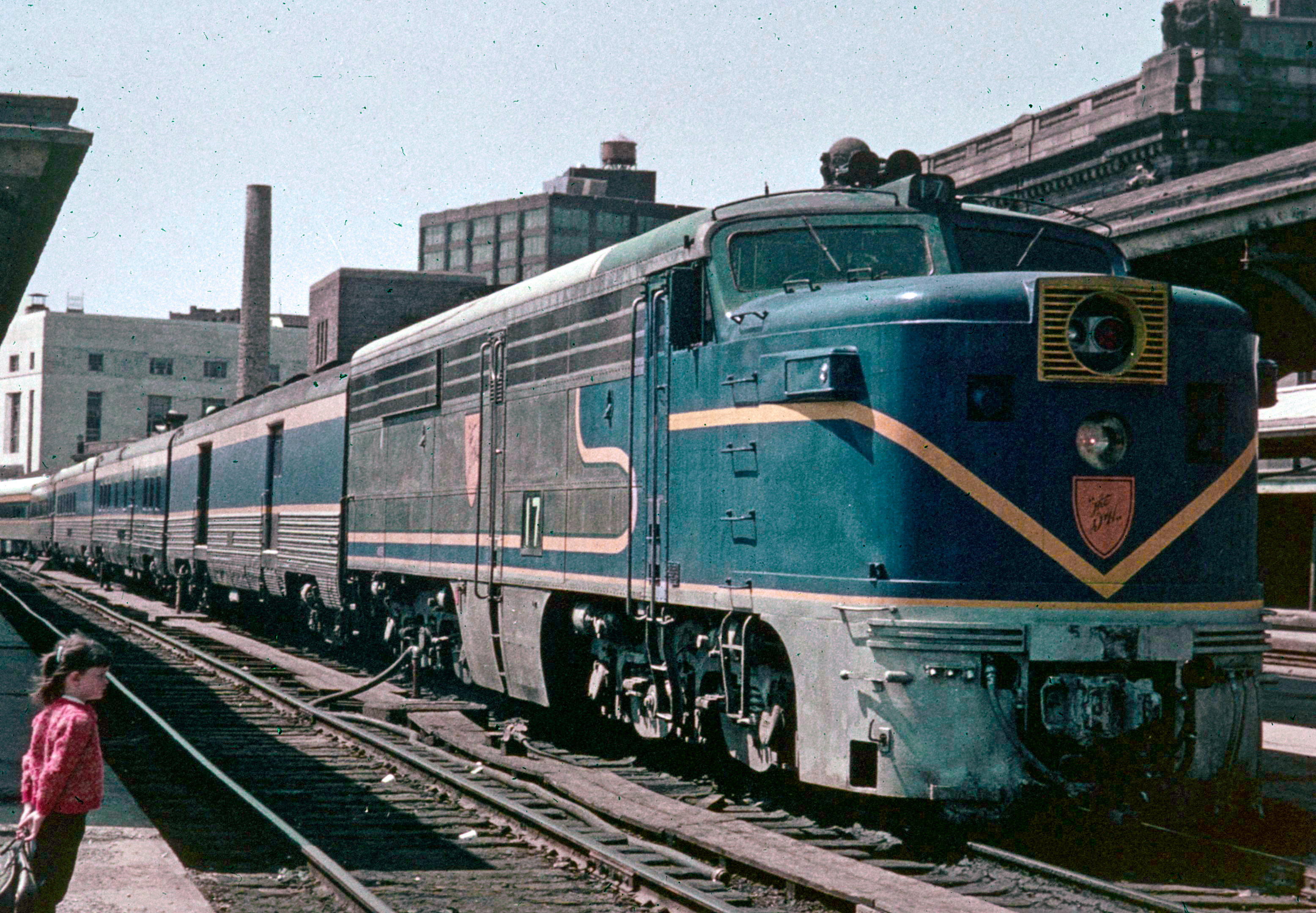 A young girl watches the Delaware & Hudson's "Laurentian" boarding at Albany, New York during the late 1960's. Carl Sturner photo. Author's collection.
A young girl watches the Delaware & Hudson's "Laurentian" boarding at Albany, New York during the late 1960's. Carl Sturner photo. Author's collection.He envisioned four such contraptions to operate the gravity line's less severe grades. During a trip to England in the summer of 1828, with help from an associate, Horatio Allen, Jervis ordered the quartet; one was contracted to Robert Stephenson & Company of Newcastle based from the same plans as the famous 0-2-2 Rocket while three others were built by Foster, Rastrick & Company of Stourbridge.
Stephenson's design was named America and the first to arrive in the States, unloaded in New York on January 15, 1829 at a cost of $3,663.30 (including delivery).
The other three machines from Foster, Rastrick & Company crossed the Atlantic a few months later; the famous Stourbridge Lion was delivered on May 13th (at a total cost of $2,914.90) while the Delaware ($2,944.40) and Hudson ($2,992.90) arrived later that summer. In a strange turn of events, only the Lion was actually tested by the Delaware & Hudson.
The America made a quick demonstration run in New York on May 27th, as did the Lion a day later on May 28th. After wowing onlookers in an event that could be argued as the first-ever utilization of steam locomotives on American soil, the duo were shipped up the Hudson to Rondout (near Kingston). From there they were to be shipped over the canal to Honesdale.
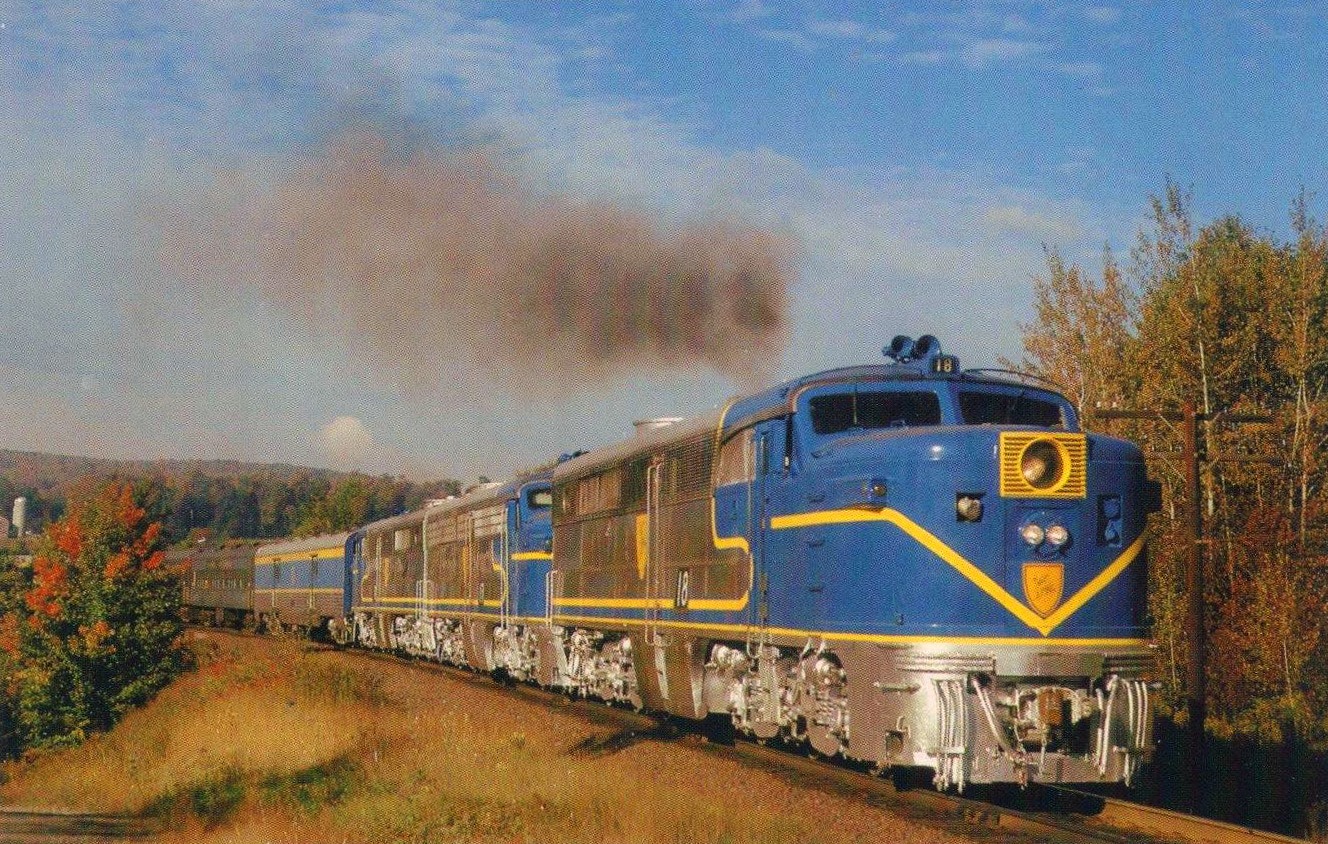 A trio of Delaware & Hudson's PA-1's (#18, #17, and #19) lead the "Susquehanna Valley Special" (Binghamton - Albany, New York) excursion near Afton, New York on September 29, 1973. Aron Blum photo.
A trio of Delaware & Hudson's PA-1's (#18, #17, and #19) lead the "Susquehanna Valley Special" (Binghamton - Albany, New York) excursion near Afton, New York on September 29, 1973. Aron Blum photo.However, the America's story is murky beyond this point. The Lion was delivered on July 24th but it has never been been proven if the America either made it to Honesdale or was left in Rondout.
In a surprising turn of events what was later discovered to be one of its cylinders was donated to the Smithsonian. It still resides at the institution today.
The Delaware and Hudson met a fate similar as America. Neither locomotive's whereabouts have ever been ascertained after their shipment to Rondout.
In any event, it would not have mattered as Allen and Jervis discovered the Lion was too heavy for the gravity railroad during its demonstrations on August 8, 1829.
Officially, tests carried out that day have been recognized as the first use of a steam locomotive in the United States.
Another trial was held on September 9th, confirming the men's initial assessment. The poor locomotive, which had operated very well, was banished to a shed in Honesdale and largely forgotten.
Roughly 20 years later it was dragged out and the boiler utilized by the D&H shops in Carbondale until 1870. The remains of the locomotive was eventually acquired by the Smithsonian and today are on display at the B&O Railroad Museum.
In 1933, the company's shops in Colonie, New York built an exact replica of the 0-4-0 Lion for the Century of Progress Exposition in Chicago. Today, the little machine sits on display in Honesdale, owned by the Wayne County Historical Society.
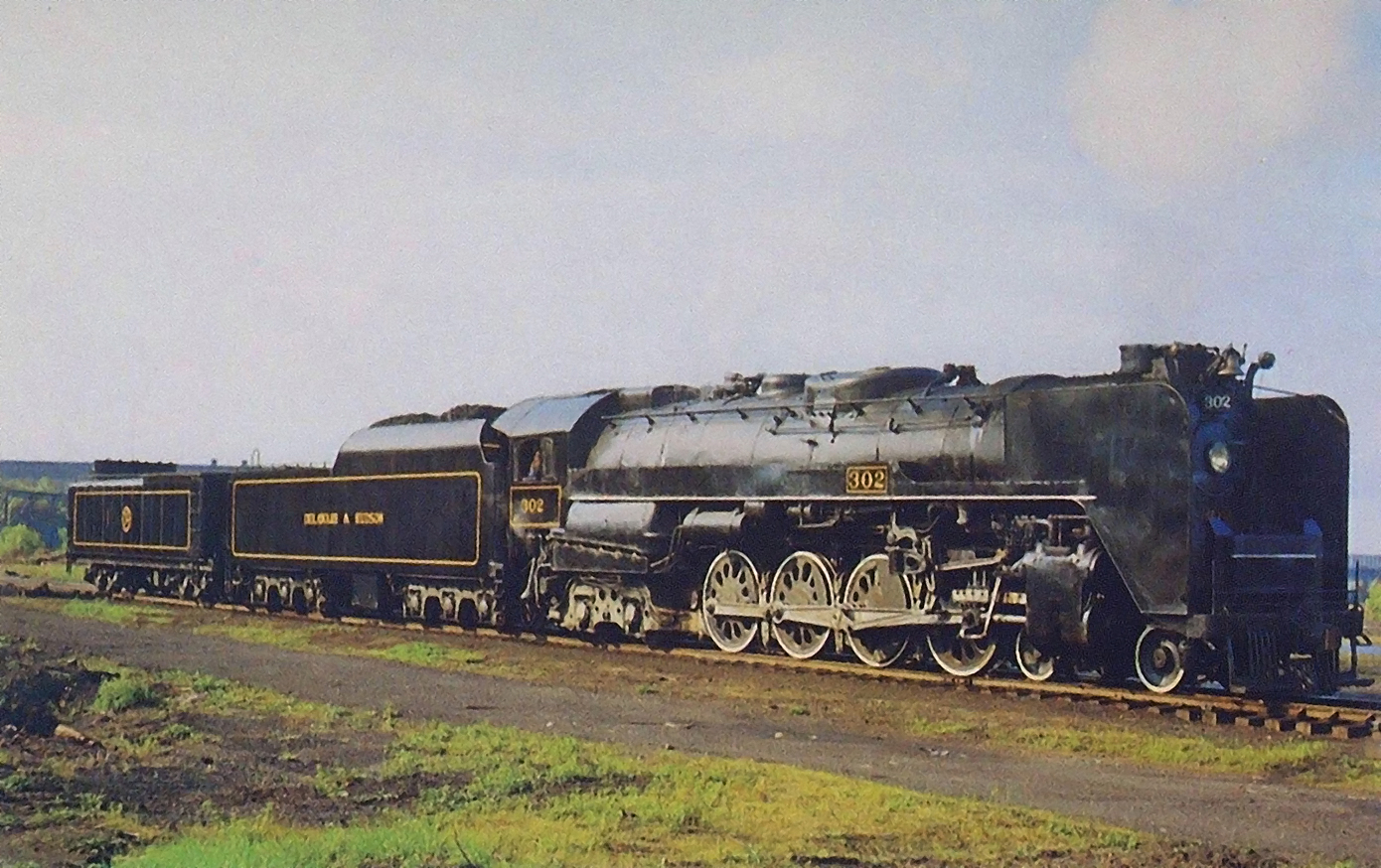 Reading 4-8-4 #2102 (T-1) is dressed as Delaware & Hudson 4-8-4 #302 (K-62) to celebrate the latter's 150th anniversary in 1973. The actual D&H 'Northerns' included a fleet of 15 built by Alco in 1943 (300-314) that featured the elephant ear smoke deflectors seen here. They were used for dual service assignments but could usually be found on passenger runs between New York and Montreal. All were scrapped during the 1950's. Jim Shaughnessy photo.
Reading 4-8-4 #2102 (T-1) is dressed as Delaware & Hudson 4-8-4 #302 (K-62) to celebrate the latter's 150th anniversary in 1973. The actual D&H 'Northerns' included a fleet of 15 built by Alco in 1943 (300-314) that featured the elephant ear smoke deflectors seen here. They were used for dual service assignments but could usually be found on passenger runs between New York and Montreal. All were scrapped during the 1950's. Jim Shaughnessy photo.Curiously, as Mr. Shaughnessy notes, despite holding distinction as operating the first steam locomotive, as well as boasting the longest railroad in the States by the fall of 1829, the D&H was slow to adopt the technology.
It did not operate its next locomotive until the Major Sykes and C.P. Wurts arrived in 1860. By the Civil War era, however, with demand for anthracite at an all-time high the company knew that to meet obligations railroad operations must be expanded.
In 1865 the last addition of any kind to its gravity operation was carried out while it purchased additional coal holdings from Carbondale to Wilkes-Barre.
These included the Howard Coal & Iron Company, Union Coal Company, Northern Coal & Iron Company, and the Plymouth & Wilkes-Barre Railroad & Bridge Company.
At the time the D&H did not have direct authority to operate the railroads included with these properties. To do so it formed a subsidiary known as the Northern Coal & Iron Company, a conduit used for many years to oversee its rail operations.
Expansion
In the years after the Civil War Delaware & Hudson's rail service expanded rapidly. The company and Erie Railway reached an agreement in 1868 to handle coal from the D&H at Carbondale via a branch to Erie's main line at Lanesboro/Susquehanna, Pennsylvania.
The product would then be shipped west to Buffalo and the Great Lakes. The route was built under the guise of the Jefferson Railroad.
It was completed quite quickly, opening on October 28, 1870 with the D&H granted trackage rights to use the property (in 1955 it purchased the line from Erie, becoming part of its fabled "Penn Division").
In May of 1867 it received privileges from New York to begin rail construction in that state. This important mandate enabled the D&H to launch rail expansion northward.
It quickly pounced on this new opportunity by entering into a lease agreement with the Albany & Susquehanna Railroad on February 24, 1870.
The A&S had been chartered in 1851 to construct a 6-foot gauge route from Albany to Binghamton, interchanging there with the-then New York & Erie (later Erie). After several starts and stops the A&S was completed on January 14, 1869.
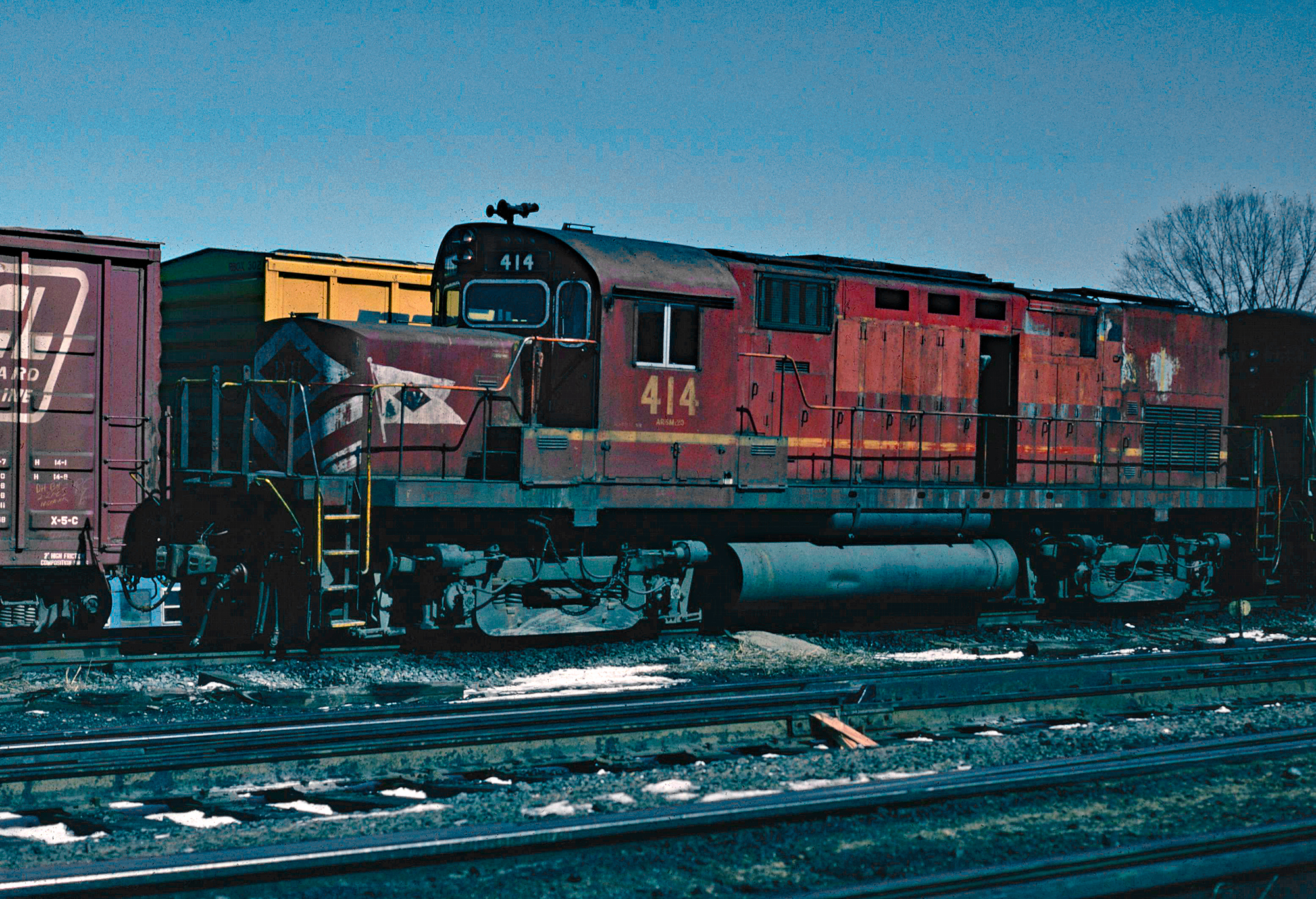 A former Lehigh Valley C420 is seen here operating on the Delaware & Hudson at Binghamton, New York in February, 1985. Bob Yanosey photo. American-Rails.com collection.
A former Lehigh Valley C420 is seen here operating on the Delaware & Hudson at Binghamton, New York in February, 1985. Bob Yanosey photo. American-Rails.com collection.For the time being D&H coal moved over the Erie from Lanesboro to the A&S at Binghamton.
To circumvent the roundabout nature of this route it drew up plans to build a 27-mile shortcut from Lanesboro to Nineveh, New York where coal could move directly across both railroads and thus eliminate the Erie in the process.
The new line was opened on June 17, 1872 providing the D&H a direct rail route from Wilkes-Barre to Albany via Binghamton.
In the coming years a series of acquisitions pieced together a main line through northern New York, western Vermont, and finally terminating at Montreal, Quebec.
It is interesting that for a company which had established the successful transportation of coal to southern markets the D&H decided to expand its rail empire in the opposite direction!
There was a very real and understandable point to all of this, of course. It already served the former region, and was attempting to open new markets for anthracite.
The Modern D&H
In his book, Mr. Shaughnessy thoroughly covers all of the Delaware & Hudson's northern expansion, superbly detailing the construction and how these lines joined its network. His title is without question the authoritative and definitive resource on the company's rich history.
For purposes of this article only a brief summary will be provided highlighting this subject. The 1870s witnessed a quick expansion of the D&H; in 1871 it leased the Rensselaer & Saratoga (R&S), stretched further north via the New York & Canada (NY&C), and finally reached Montreal via the Napierville Junction Railway (NJRR).
The R&S, formally leased during May of 1871, comprised the bulk of Delaware & Hudson's central network running from a connection with the A&S at Albany to Whitehall along the southern tip of Lake Champlain.
The R&S was originally chartered on April 14, 1832 to construct a rail line from Troy to Ballston Spa; the first segment opened from Waterford to Ballston Spa on August 18, 1835 while the entire line was completed into Troy a month later on October 6th.
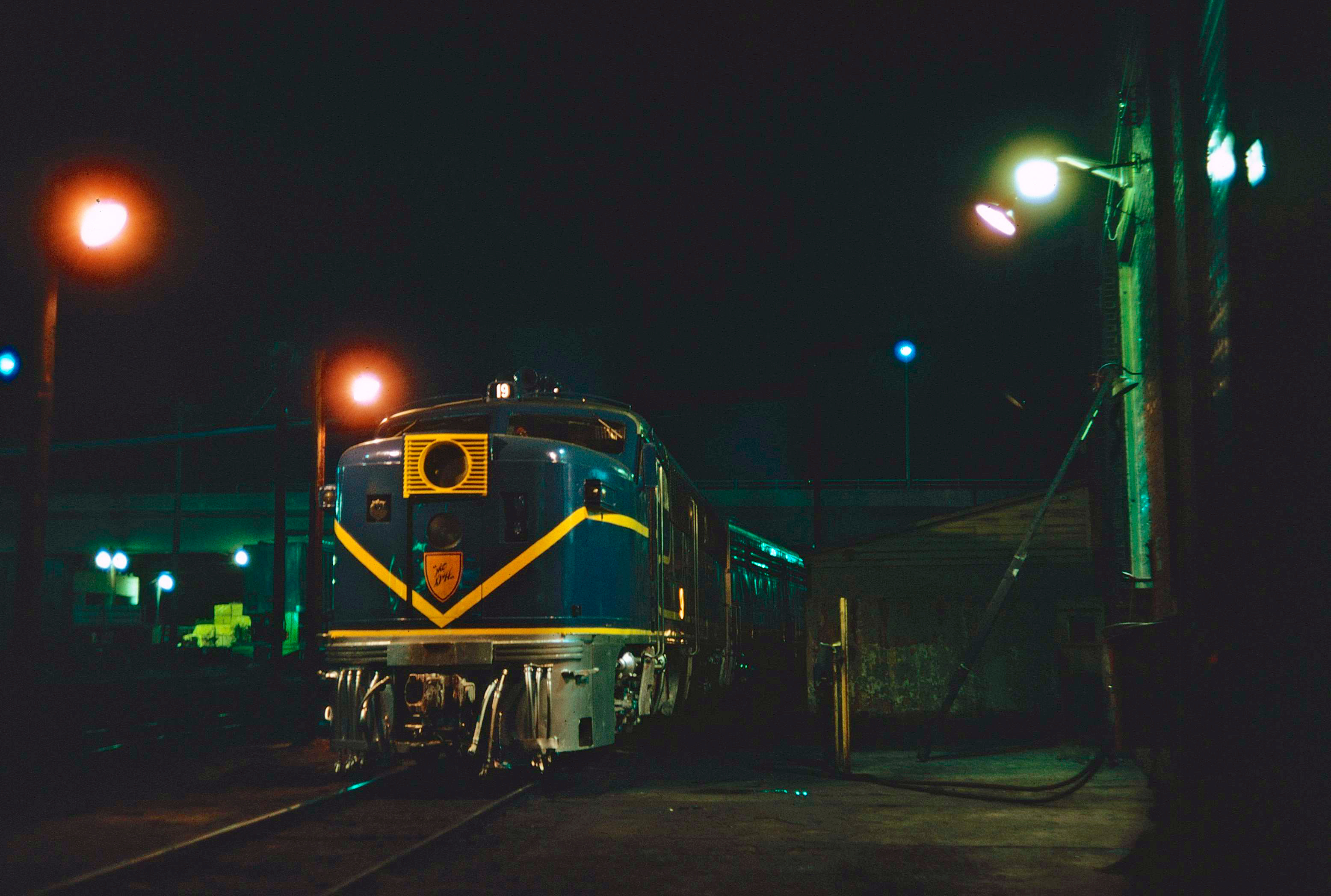 A pair of Delaware & Hudson's PAs rest near the roundhouse in Binghamton, New York on an October night in 1973. Author's collection.
A pair of Delaware & Hudson's PAs rest near the roundhouse in Binghamton, New York on an October night in 1973. Author's collection.In the succeeding years many small systems were added to the R&S network: in 1851 it leased the Saratoga & Schenectady, connecting its namesake cities and interchanging with the R&S at Ballston Spa.
The Albany & Vermont, Rutland & Washington and Troy & Rutland were a series of small roads that eventually opened between Albany and Rutland via Salem and Eagle Bridge although they were not particularly successful. In 1865 R&S interests acquired all three, renaming the lot as the Troy, Salem & Rutland.
These properties were largely responsible for forming the D&H's inside route between Rutland and Albany. Its western corridor to Whitehall and an eastern extension towards Rutland was constructed by the Saratoga & Washington, chartered in 1834 to build from Saratoga Springs to Whitehall.
The entire line opened on December 10, 1848. In 1850 it completed a short branch east of Whitehall to the Rutland & Whitehall, which extended further east to a connection with the Rutland & Washington at Castleton. The Rutland & Whitehall was soon leased by the R&S and all properties involved were leased by the Rensselaer & Saratoga in 1865.
Passenger Trains
The railroad never had a significant or large passenger fleet, obviously due to its small size. However, it did have a few notable trains including the Montreal Limited and Laurentian, the latter of which was its best known.
The Montreal Limited provided overnight service between New York City and Montreal, courtesy of help from the New York Central, while the Laurentian provided daytime connections throughout upstate New York and across the Great Lakes region.
Perhaps most interesting is that these trains grew in popularity following the arrival of new president Frederic Dumaine in 1967.
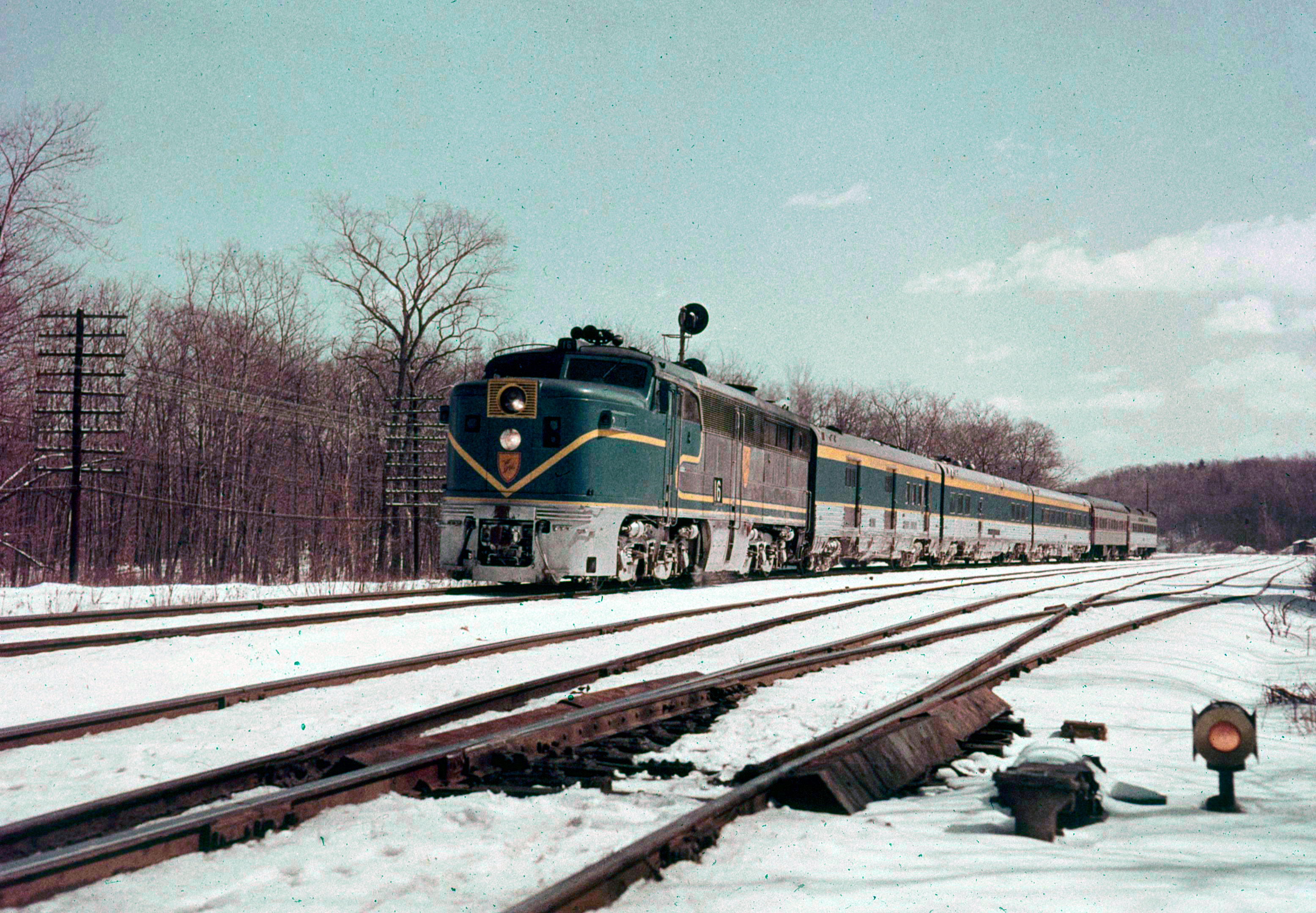 What appears to be Delaware & Hudson's train #34, the southbound "Laurentian," is led by PA #16 as it passes through Mechanicville, New York on a winter's afternoon in the late 1960's. Jim Shaughnessy photo. Author's collection.
What appears to be Delaware & Hudson's train #34, the southbound "Laurentian," is led by PA #16 as it passes through Mechanicville, New York on a winter's afternoon in the late 1960's. Jim Shaughnessy photo. Author's collection.Dumaine was a big proponent of passenger service, upgrading the fleet with newer secondhand equipment. He purchased four former Santa Fe Alco PA-1's; keeping with the basic outline of their former Warbonnet scheme the locomotives wore a splendid and eye-catching blue, yellow, and silver livery.
They were originally built as #59-L, #60-L, #62-L, and #66-L for the Santa Fe and became #16-19 on the Delaware & Hudson. In 1975, the D&H had the locomotives overhauled by Morrison-Knudsen, carrying upgraded, 2,400 horsepower model 251F prime movers.
The quartet was later sold to Mexico although in 2002 the shells of #59-L and #62-L were returned to the States for restoration; the former is undergoing work by the Museum of the American Railroad in Frisco, Texas to return it to its originally look and the later is nearly operational as Nickel Plate Road #190.
Curiously, while both trains were axed by Amtrak following its startup on May 1, 1971 a push by the Delaware & Hudson and State of New York actually worked in reviving the New York-Montreal run as the Adirondack, which still operates today.
Laurentian: (New York - Albany - Montreal)
Montreal Limited: (New York - Albany - Montreal)
To push service beyond Whitehall the New York & Canada was incorporated in 1872. On January 15, 1873 the new company officially entered the railroad business when it acquired the Whitehall & Plattsburgh and Montreal & Plattsburgh (as well as the steamship service across Lake Champlain provided via the Oakes Ames, which was soon sold off).
To simplify the corporate process a revised New York & Canada Railroad was born on February 25, 1873 to consolidate all three.
The W&P and M&P were still largely undeveloped when acquired by the NY&C. The first section from Whitehall to Port Henry, via Ticonderoga, opened on November 30, 1874 along the western shore of Lake Champlain.
This segment, and the final section to Plattsburgh which opened on November 29, 1875, was arguably the most scenic along the Delaware & Hudson's entire system overlooking Willsboro Bay.
In one location a 606-foot tunnel was needed while another featured a tight rocky shelf carved out of the Red Rocks high above the bay. It became an often photographed spot on the D&H.
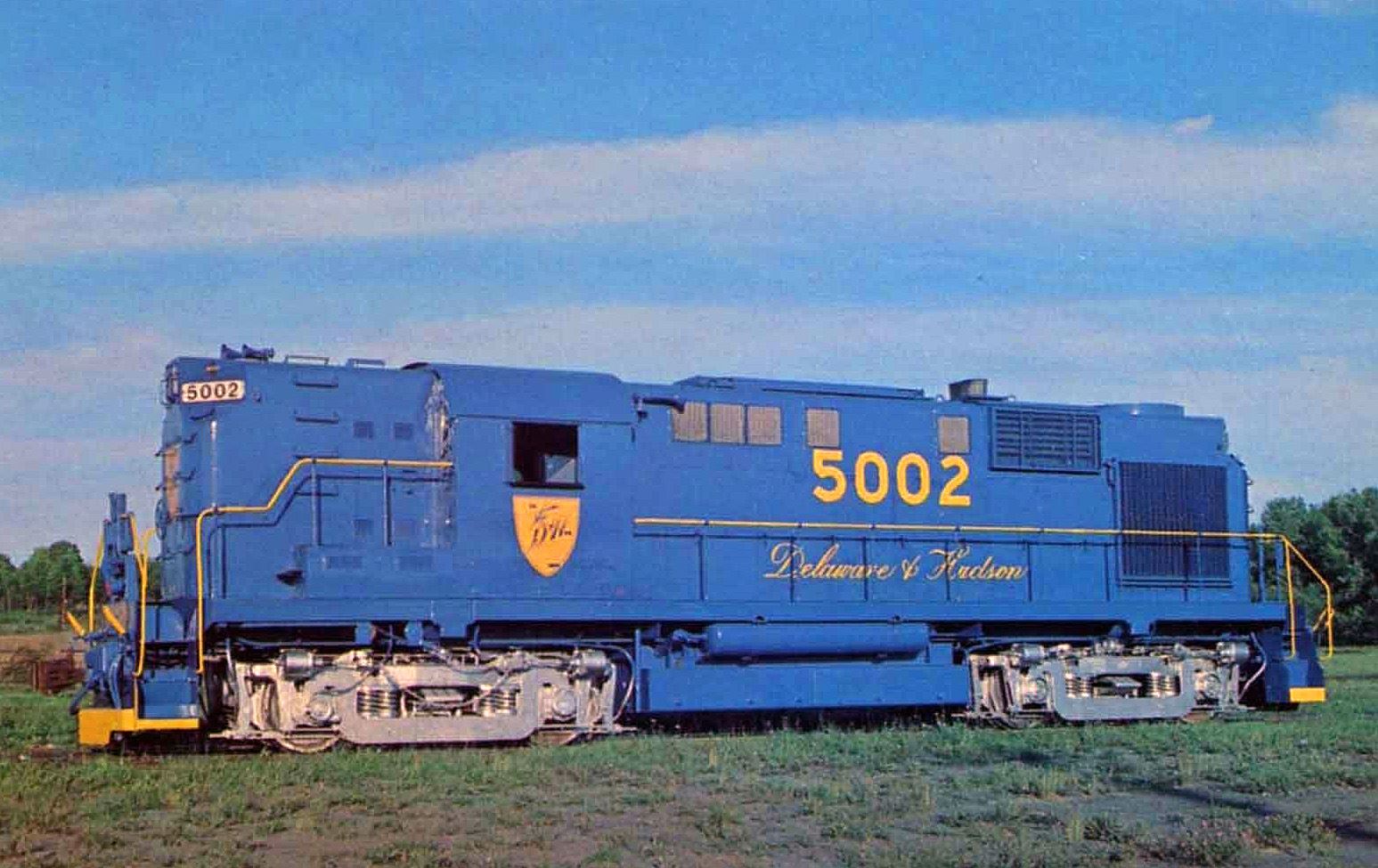 Delaware & Hudson RS11 #5002 poses for a portrait at the industrial park in Voorheesville, New York on August 18, 1977. Jim Shaughnessy photo.
Delaware & Hudson RS11 #5002 poses for a portrait at the industrial park in Voorheesville, New York on August 18, 1977. Jim Shaughnessy photo.The company now had direct rail service to Canada although not over its own rails; above Plattsburgh the D&H utilized trackage rights over the Ogdensburgh & Lake Champlain for 12 miles to Rouses point where a connection was reached with the Grand Trunk Railway to move coal, freight, and passengers onto Montreal.
To circumvent this issue the D&H built its own line from Plattsburgh to Rouses Point, opening the route in November of 1876. The final extension to Montreal came via the Napierville Junction Railway, which the D&H acquired on April 9, 1907.
The NJRR linked Rouses Point with St. Constant with trackage rights via the Grand Trunk to St. Lambert along the eastern shore of the St. Lawrence River.
To reach downtown Montreal the D&H secured additional rights over the Canadian Pacific's bridge spanning the river. With this final piece in place the modern Delaware & Hudson was essentially complete.
There were a handful of other branches, notably the Adirondack Railway and Chateaugay & Lake Placid (C&LP); these two roads were originally conceived to serve Upstate New York's early iron ore industry.
The C&LP was a July 29, 1903 consolidation of the Chateaugay Railroad and Saranac & Lake Placid, which the D&H acquiring on that date. The system stretched from a connection at Plattsburgh to Saranac Lake/Lake Placid via Loon Lake.
It was once a popular tourist destination for travelers escaping to resorts in the Adirondacks. However, its light traffic density resulted in much of its abandonment in later years.
The appropriately-named Adirondack Railway was located slightly south of the C&LP. Its origins date back to 1826 when rich deposits of iron ore were discovered near present-day Mount Marcy.
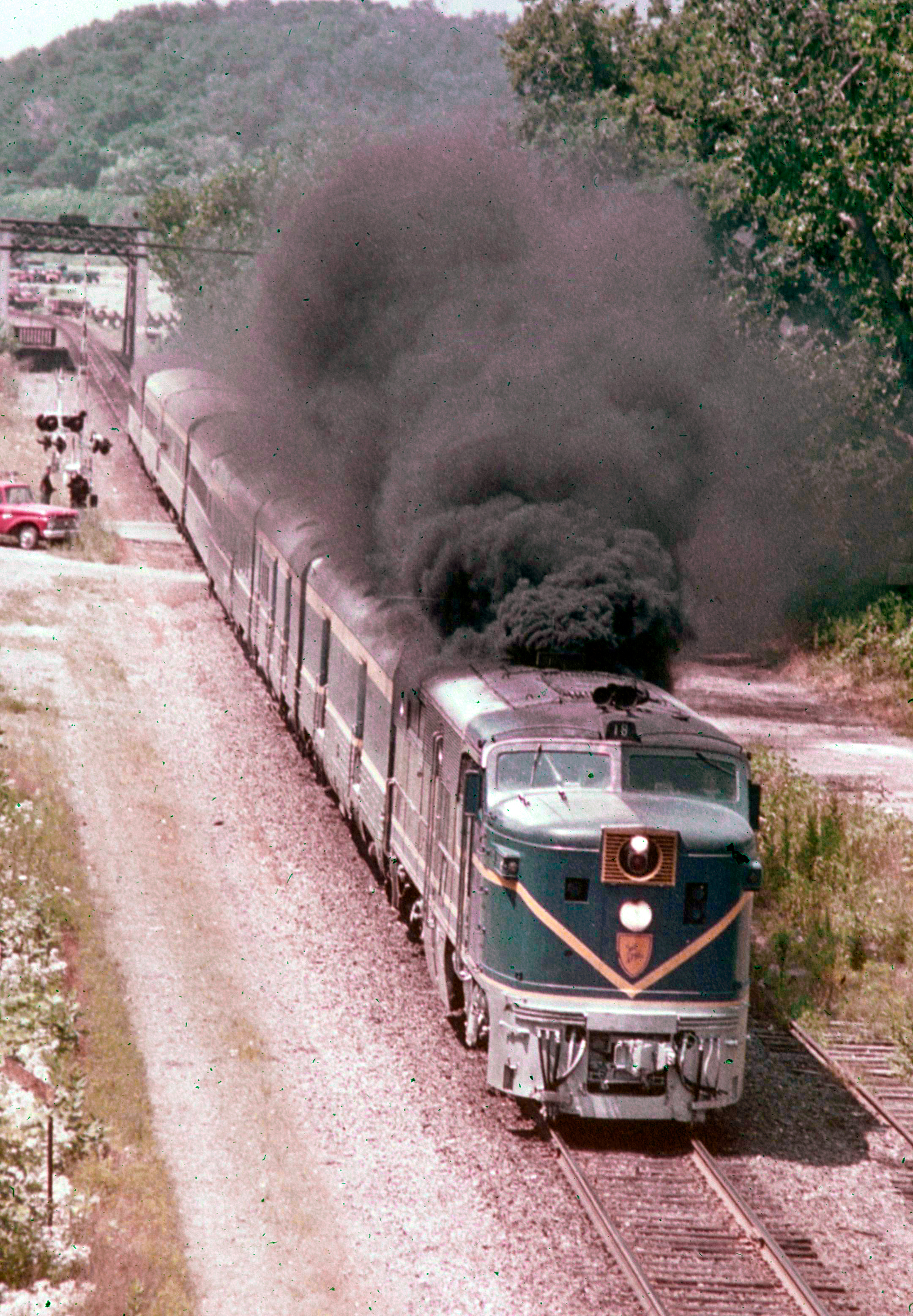 Delaware & Hudson PA #18 throttles up as it departs Waterford, New York with the northbound "Laurentian," in the late 1960's. Jim Shaughnessy photo. Author's collection.
Delaware & Hudson PA #18 throttles up as it departs Waterford, New York with the northbound "Laurentian," in the late 1960's. Jim Shaughnessy photo. Author's collection.The first prospects for a railroad did not begin until the Sackets Harbor & Saratoga Railroad was incorporated in 1852 to build a line from Saratoga Springs to Lake Ontario. Unfortunately the idea, and others, never made it beyond the planning stages until the Adirondack Company was formed on October 24, 1863.
The idea of reaching Lake Ontario at Ogdensburg or Sackets Harbor was soon abandoned for more realistic goals. After a series of financial hardships the railroad opened from Saratoga Springs to North Creek in early 1871.
During the financial Panic of 1873 the Adirondack Company entered receivership and the railroad became known as the Adirondack Railway on September 29, 1881. After a few additional years of private operation it was sold to the Delaware & Hudson on June 11, 1889.
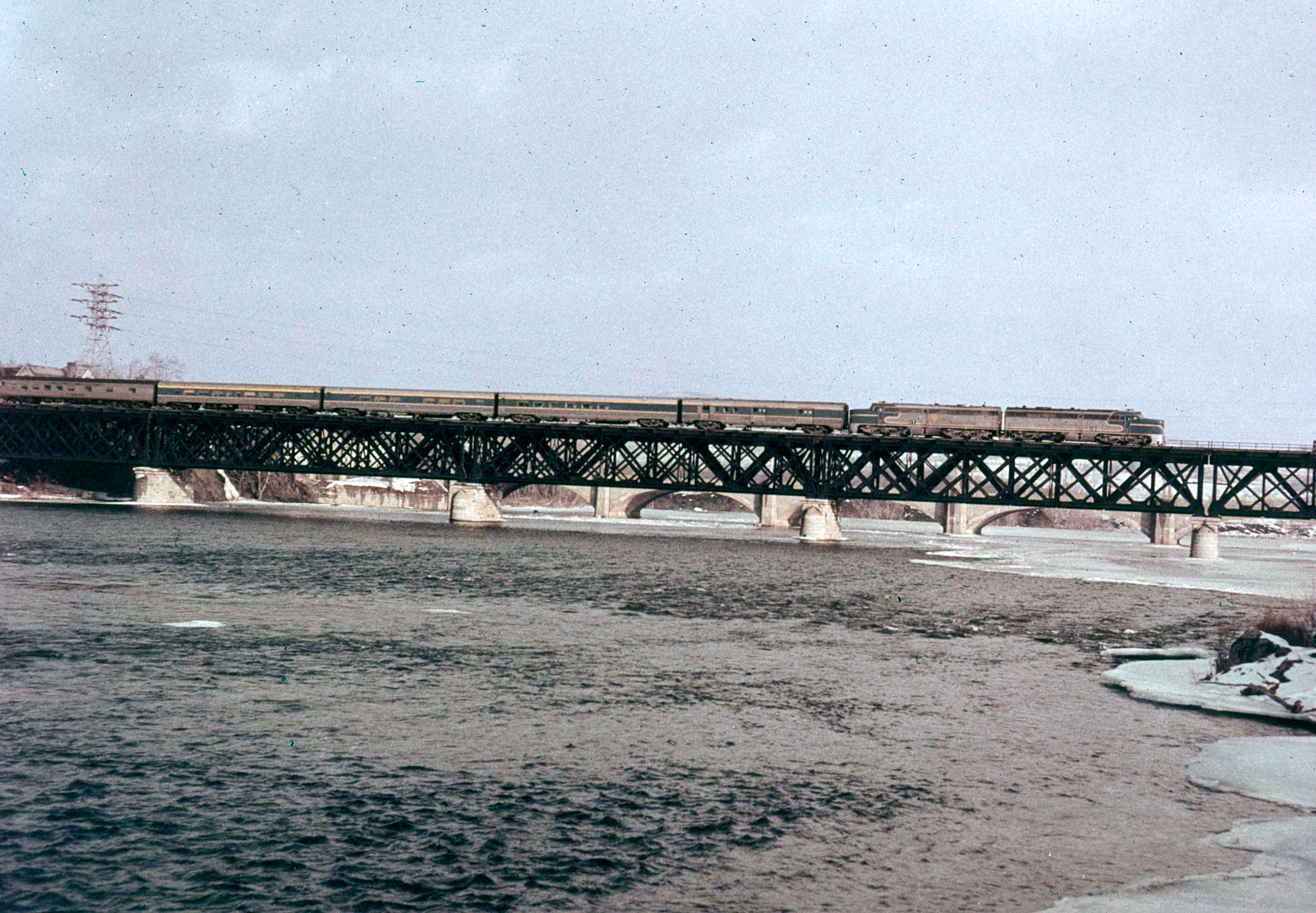 Delaware & Hudson PA's #19 and #17 cross the Mohawk River at Cohoes, New York with the southbound "Laurentian," on a winter's day in the late 1960's. Jim Shaughnessy photo. Author's collection.
Delaware & Hudson PA's #19 and #17 cross the Mohawk River at Cohoes, New York with the southbound "Laurentian," on a winter's day in the late 1960's. Jim Shaughnessy photo. Author's collection.Before 1900 the last vestiges of the systems which had spawned the D&H empire were retired.
It was a rather sad day on November 5, 1898 when the final boat loaded with coal worked its way over the canal while the gravity railroad discontinued service a few months later on January 3, 1899 (segments were later overhauled for standard steam locomotive operation).
As the company was no longer in the canal business the title as the Delaware & Hudson Canal Company seemed rather pointless.
As a result a name change was carried out a month after the gravity operation ceased; in February, 1899 the Delaware & Hudson Company was organized and officially recognized by the state of New York later that April.
System Map (1940)
Three decades later one final name change occurred when the Delaware & Hudson Railroad Corporation was created in 1930 to operate the railroad and all subsidiary properties of the Delaware & Hudson Company.
The modern D&H system comprised a system of just over 700 miles; its 1950 network was listed at 765 miles.
Interestingly, it briefly eyed expansion deep into New England through a one-time ownership of the Rutland Railway during the late 19th century and even considered pushing further north into Canada. However, both prospects were eventually dropped.
System Map (1969)
After World War II the great decline of anthracite began as roads like the D&H, Jersey Central, Lehigh Valley, Lackawanna, and others struggled to find an alternative to this important source of freight.
According to Mike Schafer's book, "More Classic American Railroads," anthracite still comprised more than half of the railroad's annual freight tonnage through the 1930s.
It did handle other business such as cement, iron ore, steel, wood products, and even some bituminous coal although not in large enough volumes to replace anthracite.
To make up for the loss it turned to bridge traffic. This business moved from New England points and others throughout the Northeast, subsisting the D&H through the 1970s.
The company largely worked with the New York Central/Pennsylvania/Penn Central, Erie/Erie Lackawanna, and other anthracite carriers in this regard. Its Montreal gateway was a somewhat unique asset, only the NYC and Central Vermont served Quebec's important southern metropolis.
During the 1950s the D&H was still a healthy and strong carrier at which time it entered into talks with the Delaware, Lackawanna & Western and Erie regarding a three-way merger.
According to H. Roger Grant's authoritative title, "Erie Lackawanna: Death Of An American Railroad, 1938-1992," the D&H was the strongest of the three and certainly would have greatly aided the new company's outlook.
However, it backed out of the proceedings formally on April 13, 1959. Ironically, it wound up with the EL anyway when it officially joined Norfolk & Western's Dereco, Inc. on July 1, 1968.
Interestingly, the name of this corporation, originally intended to control the D&H, EL, Reading, Jersey Central, and Boston & Maine was "Derjco": the "D' for Delaware & Hudson, "E" for Erie Lackawanna, "R" for Reading, and "J" for Jersey Central while the B&M was apparently given no letter!
Comically, it was shortened to "Dereco" which was easier to pronounce according to the N&W's top brass.) The D&H remained a ward of Dereco until Hurricane Agnes forced the EL into bankruptcy and the N&W lost interest in its portfolio.
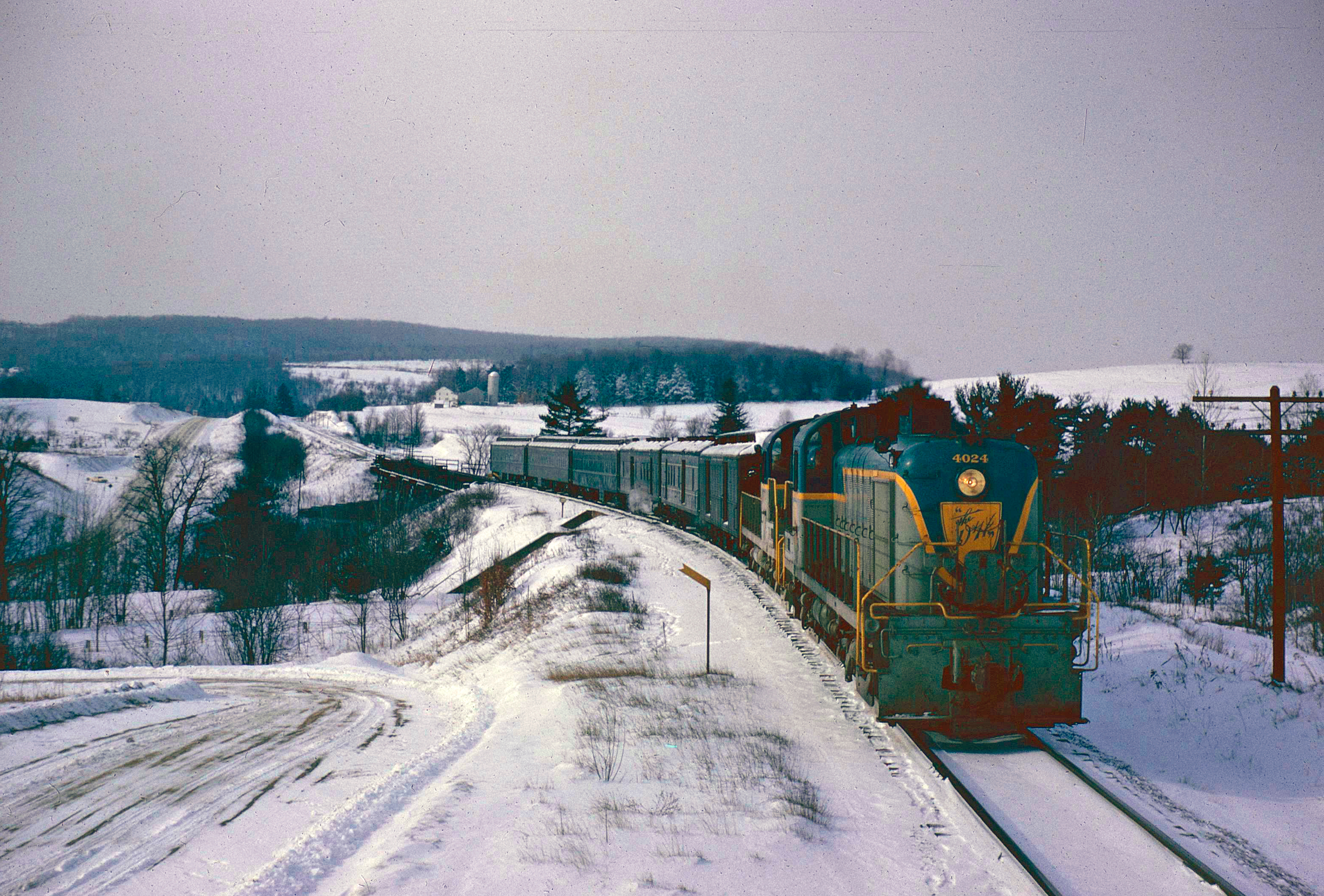 Delaware & Hudson RS2's have the final northbound train #205 (Binghamton-Albany) passing through Harpursville, New York on January 24, 1963. Author's collection.
Delaware & Hudson RS2's have the final northbound train #205 (Binghamton-Albany) passing through Harpursville, New York on January 24, 1963. Author's collection.With the collapse of the Penn Central and nearly all other Northeastern carriers the railroad was destined to likely disappear into either the Consolidation Rail Corporation (a quasi-government entity designed to revive the Northeast's bankrupts) or another large carrier.
Instead, in an effort to retain a semblance of rail service in the region the D&H remained and was even provided a broader market to offer competition against Conrail. The result was a railroad which nearly doubled in size when Conrail started on April 1, 1976!
The new routes provided the D&H trackage rights over Conrail between Binghamton and Buffalo (and a connection with the Norfolk & Western) as well as Newark (New Jersey), Philadelphia and Washington, D.C. In 1980 it purchased the ex-DL&W main line between Binghamton and Scranton.
From a railfan perspective it was a sad event which led to the abandonment of the fabled Penn Division soon afterward; D&H could now reach Binghamton direct via Wilkes-Barre and Scranton instead of utilizing the old twisting and rugged route to Nineveh via Lanesboro. To read more about the route's history please click here.
Diesel Roster
American Locomotive Company
| Model Type | Road Number | Date Built | Quantity |
|---|---|---|---|
| PA-1/4 | 16-19 (Ex-AT&SF) | 1947-1948 | 4 |
| C420 | 200-209 (Ex-LV), 404-415 (Ex-LV) | 1963-1964 | 22 |
| C424 | 451-463 (Ex-EL and Ex-Reading) | 1963 | 13 |
| C628 | 601-618 | 1964-1965 | 18 |
| S2 | 3000-3032 | 1944-1949 | 33 |
| S4 | 3033-3050 | 1950 | 18 |
| RS2 | 4000-4024, 4050-4051 | 1944-1949 | 27 |
| RS3/m | 4026-4129 | 1950-1954 | 104 |
| RS11 | 5000-5011 | 1960-1961 | 12 |
| RS36 | 5012-5023 | 1963 | 12 |
Baldwin Locomotive Works
| Model Type | Road Number | Date Built | Quantity |
|---|---|---|---|
| RF16 | 1205, 1216 (Ex-NYC) | 1951 | 2 |
Electro-Motive Division
| Model Type | Road Number | Date Built | Quantity |
|---|---|---|---|
| SD45 | 801-803 | 1966 | 3 |
| GP38-2 | 7314-7325 (Ex-LV) | 1972 | 10 |
| GP39-2 | 7401-7420 (Ex-Reading), 7601-7620 | 1974-1976 | 40 |
General Electric
| Model Type | Road Number | Date Built | Quantity |
|---|---|---|---|
| U23B | 301-316 | 1968 | 16 |
| U30C | 701-712 | 1967 | 12 |
| U33C | 650-656 (Ex-PC), 751-753 (Ex-EL), 754-762 | 1968-1970 | 19 |
Steam Roster
| Class | Type | Wheel Arrangement |
|---|---|---|
| B-4 Through B-7 | Switcher | 0-6-0, 0-8-0 |
| C-1, C-2 | Mogul | 2-6-0 |
| D-3 (Various) | Ten-Wheeler | 4-6-0 |
| E-2 Through E-7 | Consolidation | 2-8-0 |
| E-7 | Twelve-Wheeler | 4-8-0 |
| H | Articulated | 0-8-8-0 |
| H-1 | Articulated | 2-6-6-0 |
| J | Challenger | 4-6-6-4 |
| K | Northern | 4-8-4 |
| P, P-1 | Pacific | 4-6-2 |
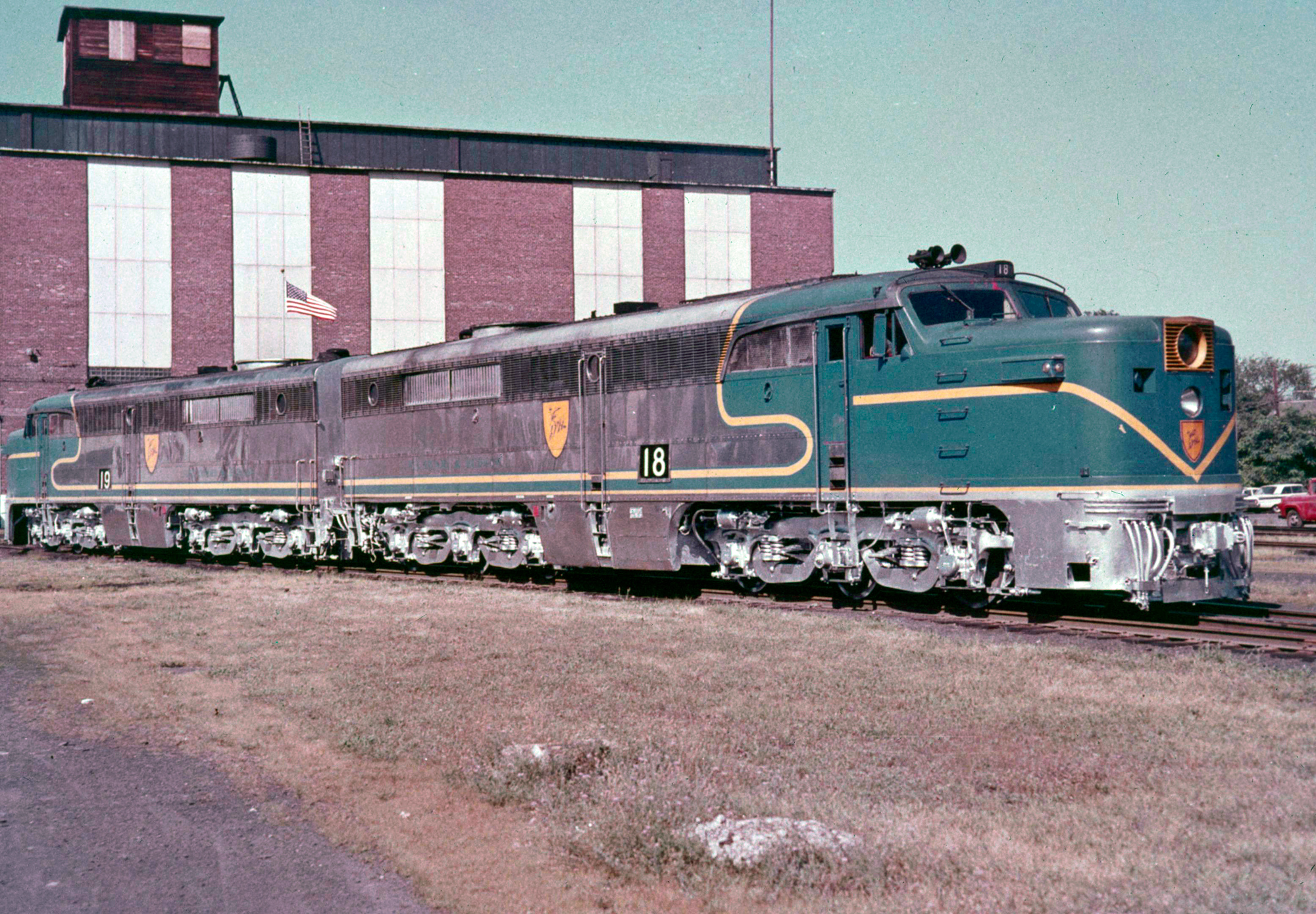 Delaware & Hudson PA-1's #18 and #19 bask in the sun outside the shops in Colonie, New York during the late 1960's. Jim Shaughnessy photo. Author's collection.
Delaware & Hudson PA-1's #18 and #19 bask in the sun outside the shops in Colonie, New York during the late 1960's. Jim Shaughnessy photo. Author's collection.Final Years
Alas, due to the railroad’s small size it was eventually destined to be purchased, which happened in 1981 when Guilford Transportation acquired the property.
The D&H lasted only a few years in the Guilford system before its purchase by the Canadian Pacific in 1991, which slowly merged operations with its own.
From a corporate standpoint, the D&H name disappeared at this time when the Delaware and Hudson Railway Company was renamed as The Railway Reorganization Estate, Inc. on February 26, 1991.
In 2014, Norfolk Southern announced its intent to purchase a section of the former D&H main line.
The acquisition was approved by the Surface Transportation Board in May of 2015; it consists of 267 miles of former D&H main line between Sunbury/Kase, Pennsylvania and Schenectady, New York as well as 15 miles from Voorheesville Junction to Delanson, New York.
As a result, today most of what remains of the original railroad is split between NS and CP. The little D&H lived an interesting and fascinating life. While the railroad itself is all but a memory it continues to live on in a historical society dedicated to its history.
Public Timetables (January, 1930)
Contents
Recent Articles
-
Connecticut Ice Cream Train Rides: A Complete Guide
May 23, 25 12:43 AM
In this guide, we’ll explore some of the best ice cream train rides in Connecticut, revealing how each offers something special for visitors of all ages. -
Massachusetts Ice Cream Train Rides: A Complete Guide
May 23, 25 12:24 AM
Among the state's charming and slightly under-the-radar attractions are the delightful ice cream train rides that chug through scenic routes, offering a blend of sensory pleasures. -
Maryland Ice Cream Train Rides: A Complete Guide
May 22, 25 08:38 PM
Here’s a comprehensive guide to ice cream train rides in Maryland, perfect for families, couples, and anyone with a sweet tooth.
